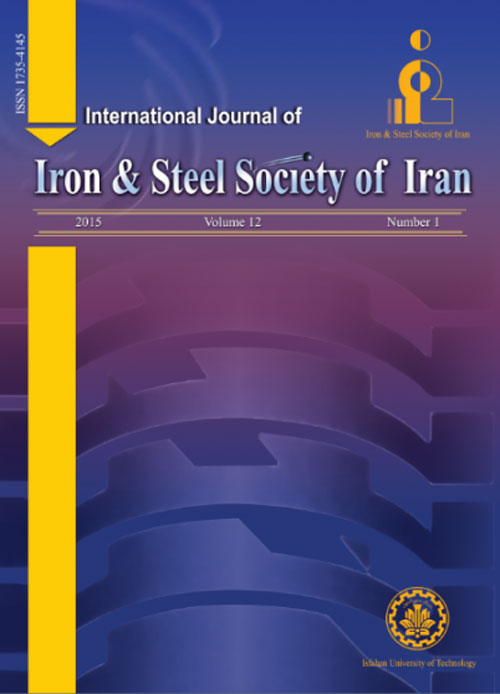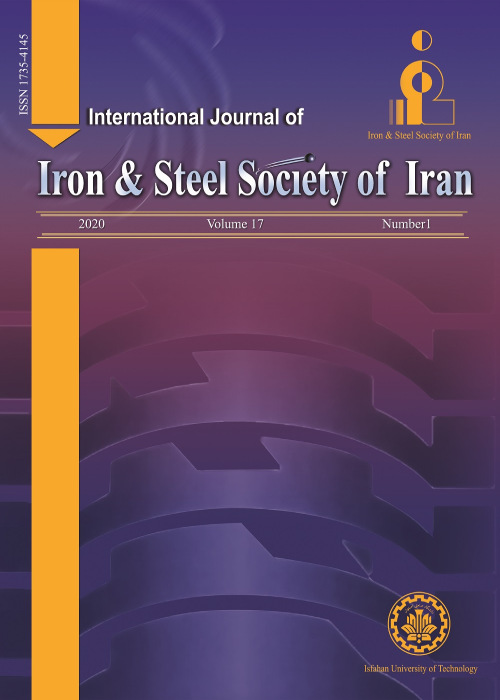فهرست مطالب

International Journal of iron and steel society of Iran
Volume:12 Issue: 1, Summer and Autumn 2015
- تاریخ انتشار: 1394/07/05
- تعداد عناوین: 7
-
-
Pages 1-8Mo40 low-alloy steels are mostly used to produce industrial components such as crane wheels which are exposed to abrasive wear. However, during working conditions, their wear resistance is reduced after a while due to its low hardness. With increasing abrasive wear, the dimensions of components decrease and they need to be repaired for surface modification. In this regard, hard overlay coatings are applied by hard-facing process for reusing these components. This work deals with the surface analysis, hardness and wear behaviors of the clad layers made of the Fe-Cr-C based hard-facing on the Mo4 low-alloy steel by submerged arc welding method. The overlay coatings are performed by two ways of welding: 1. rods of UP6-GF-50 (307 kavosh joosh standard number), and 2. UP6-GF-50-C (420 kavosh joosh standard number) regarding the Din 8555 standard, in single and double passes. According to the X-ray diffraction analysis and microstructure characteristics, both martensite with retained austenite phases and the (Fe, Cr)23 C6 carbides were identified within the overlay coatings. The presence of the carbon and chromium elements in hard surfaced specimens (as denoted by 307 and 420) produced by single and double pass were increased. The wear resistance in the coatings of 307 and 420 produced by double pass are higher than the coatings produced by single pass. In addition, the amount of average hardness in the coatings of 307 and 420 produced by single and double passes increases from 36 to 38 HRC and from 39 to 42 HRC, respectively. Based on the scanning electron microscopy micrographs, the wear mechanisms of specimens with high hardness are adhesive and tribochemical wear.Keywords: Mo40 steel, Submerged arc welding, Coating, Hard, facing, Wear resistance
-
Pages 9-15To investigate the effect of tempering treatment on mechanical properties and the microstructure of DIN 1.4021 Martensitic Stainless Steel, austenite treatment was conducted for the samples at 1000 ºC temperature for 60 min and then the samples were oil quenched. Later, tempering treatments were performed for the samples at 500 ºC and 700 ºC temperatures for 2 and 5 h, respectively; then quenching in oil was conducted. After the heat treatment, hardness, tensile strength and impact tests were performed to investigate mechanical properties. Moreover, optical microscopy and field emission scanning electron microscopy (FESEM) were performed to investigate microstructure observations and fracture surfaces. X-Ray diffraction (XRD) was carried out to measure the austenite retained in the samples. The results showed that due to the formation and precipitation of alloy carbides Cr7C3, the tempering treatment at a temperature of 500 ºC increases hardness, tensile strength and yield strength and reduces the amount of impact energy of the samples as well.Keywords: DIN 1.4021, Martensitic stainless steel, Temper, Mechanical properties, FESEM
-
Pages 16-20The mechanical properties and microstructural developments of 321 stainless steel during thermomechanical process were investigated. The repetitive cold rolling and subsequent annealing were conducted to achieve nanocrystalline structure in an AISI 321 stainless steel. Heavily cold rolling at −20°C was conducted to form martensite in metastable austenitic steel. The process was followed by annealing treatment at 700–850 °C for 0.5–30 min. The effects of process parameters such as “reduction percentage”, “annealing temperature”, and “annealing time” on the microstructural development were also investigated. Microstructural evolutions were conducted using feritscope, X-ray diffraction and scanning electron microscope (SEM). The mechanical properties were determined by hardness (Vickers method) and tensile test. The results indicated that more thickness reduction made more martensite formation, leading to the rise of hardness. In addition, mechanical evaluations after heat treatments revealed that decreasing austenite grain size to 0.7 μm resulted in hardness and strength increment by adapting Hall-Petch equation.Keywords: Austenitic stainless steel, Deformation induced martensite, Nano, ultrafine grain structure, Thermomechanical treatment, Hall, Petch relationship
-
Pages 21-27Stress relieving is a common practice among manufacturing codes for reducing the magnitude of residual stresses in welded, quenched, and tempered steel structures and pressure vessels. The present work investigates the effect of stress relieving at 480, 560, 620, and 680°C on the microstructure and mechanical properties of 20 mm ASTM A517 Gr. B steel plate weldments produced by shielded metal arc welding (SMAW). For this purpose, metallographic analysis, hardness measurement, charpy V-notched impact test, and tensile test were performed. Result showed that stress relieving reduced the impact toughness of all the base metals but better mechanical properties (hardness, tensile stress and impact toughness) were achieved when it was accomplished at 560°C.
-
Pages 28-32This experimental study investigated the effects of quenching and tempering heat treatment on fatigue behavior and also tempering temperature and time holding of AISI 1060 steel. At first, the specimens were austenitized at 800˚C for 1 hour, and then were quenched in the water bath of 2 ˚C temperature. After that, tempering process was done at the temperature of 250˚C, 450˚C and 650˚C for 1 and 2 hours. The results of mechanical properties indicated that hardness, tensile strength and fatigue limit was decreased with increasing the holding time and tempering temperature. Scanning electron microscope (SEM) results showed that crack propagation in the tempered specimens at the 250˚C temperature in the 1 hour was slower than in the specimens in the higher temperature and higher period time. As well, with increasing of the tempering temperature, germination areas of fatigue crack was increased and crack propagation was done faster.Keywords: AISI 1060 Steel, Tempering, Hardness, Tensile, Fatigue
-
Pages 33-36Environmental degradation and Economic growth are two important proofs in sustainable development which are followed by steel industry. In this case, energy and environmental damages as sustainability patterns of environment have been investigated in three different dust collectors to select the most environmentally suitable dust collector for electric furnace. In this article, the consumption amount of energy and costs and environmental damages due to the Energy Consumption are determined in Venturi Scrubber (V.S), Bag Filter (B.F) and Electrostatic Precipitator (E.S.P) connected to 1 of steel in ton electrical furnaces industry by using computational methods In this way total costs in 3 mentioned dust collectors were calculated in furnace with capability of one tonnage. The results showed that the total costs of dust collectors due to energy and environmental damages in one ton furnace during one year are 152 dollars in Electrostatic Precipitator, 566 dollars in Bag Filter, and 724 dollars in Venturi Scrubber, respectively. For example in Mobarakeh iron & steel plant, EAF with 200 tonnages these numbers are 30000 - 140000 US $ per year. It can be concluded that if the steel industry is located near the rural and urban areas, the best dust collector will be Bag Filter, if the steel industry is located far from urban and rural areas, the best dust collector is Electrostatic Precipitator.
-
Pages 37-41Silica refractory bricks are used especially in the metallurgical industries, due to desirable properties such as high melting point, rigidity, and high temperatures strength. In this research, differentamount of SiC were added to Silica refractory containing different binders such as Borax, Boric acid, Calcium nitride, Sodium tri poly phosphate, Sodium hexa meta phosphate (SHMP) and lime. Physical properties (density and porosity), mechanical properties (cold crush strength, CCS) and microstructure were studied. This study indicated that SiC improves the physical and mechanical properties. In general, increasing SiC with different binders improve the mechanical and compaction in the samples. Silica refractory sample containing 20 %wt. SiC and 5 % wt. borax as a binder had the best results of mechanical strength and compaction. In this sample, glassy phases fill the voids and increase temperature between particles. In fact, glass phase formation increases compaction, density, and strength.Keywords: AISI 1060 Steel, Tempering, Hardness, Tensile, Fatigue


